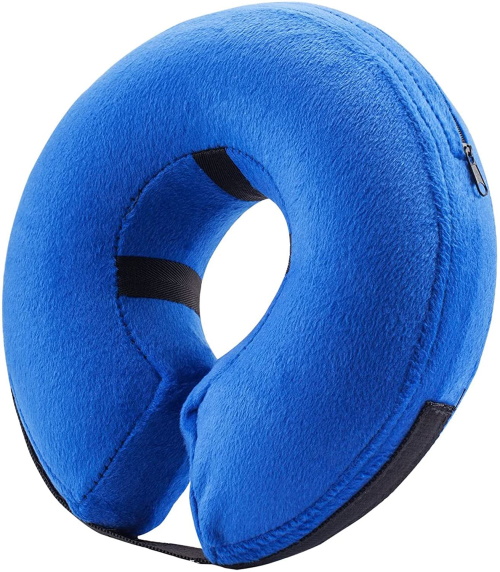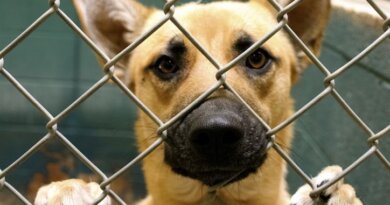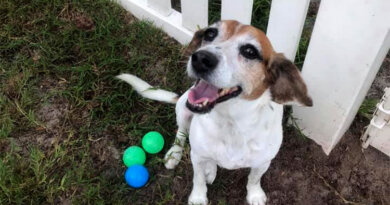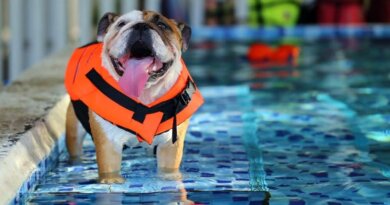How to Keep Your Dog From Licking Their Wounds
Although wound licking in dogs can help remove some debris it’s important to note that it can cause serious adverse reactions, especially with large wounds.
It’s important to keep an eye on your dog, and do your best to ensure they leave their wound alone during the healing process. Easier said than done — I know, but there are some tips that make it a bit easier to manage. Here’s how to keep your dog from licking their wounds.
Why Do Dogs Lick Their Own Wounds?
Before we get into how to stop your dog from licking their wounds let’s take a quick look at why they’re doing it to begin with. Understanding the why can help make the recovery process a little easier, since you’ll know what to look for and understand why your dog is so insistent when it comes to getting to that wound.
Wound licking is an instinctive response in dogs, and it’s one that’s found in many other animals. Their mouth is the only tool they have at their disposal to try to clean up wounds. They can’t go to the medicine cabinet and grab some disinfectant, so they use the only thing they’ve got — their mouth. It’s the only way they know how to help themselves heal.
Why licking? Well, saliva contains some beneficial materials that can help promote healing. It contains a protein called tissue factor (also called platelet tissue factor) that can help promote blood clotting. Dog saliva also contains Opiorphin, which has a pain reducing effect.
The belief that wound licking can have some curative effects has been around for ages, and in the past we utilized dogs to help heal some of our own wounds. The Egyptians believed that being licked by a dog, especially on an open wound, helped aid in recovery and even cure some illnesses. In ancient Greece, dogs at the shrine of Aesculapius (a hero and god of medicine) were trained to lick patients. And in Armenian culture Aralezes (dog-like creatures or spirits) descended from the sky to lick the wounds of the fallen so they could resurrect.
We don’t use those methods anymore thanks to modern medicine, but our dogs still do. And while licking minor wounds may not cause much of a problem for your dog, there are serious risks when it comes to larger, deeper wounds.
The Dangers of Wound Licking
Although some of the bacteria in dog saliva can be beneficial to healing, licking a wound can also cause adverse reactions and delay the healing process. Harmful pathogens can get inside a wound as a result of licking, and that risk is higher when dealing with a big wound.
When it comes to surgical wounds licking can break down your dog’s stitches, causing their wound to re-open. That increases their risk for infection, including secondary infections and tissue destruction.
How to Keep Your Dog From Licking Their Wounds
When it comes to keeping your for from licking their wounds you have a few different options, from the traditional E-collar to using distraction techniques. Here’s a look at the pros and cons of each of these methods.
Elizabethan Collar
The Elizabethan collar is commonly referred to as the cone of shame or e-collar (not to be confused with an electric training collar) is a protective medical device that prevents animals from licking or scratching wounds. It’s a flexible plastic cone that’s attached to your dog’s collar or neck, and the cone itself acts as a barrier.
If your dog is going to be having surgery chances are your veterinarian’s office will be sending them home with an e-collar. Don’t be afraid to ask your vet any questions you have about the collar, including how often they have to wear it and whether it’s OK to remove during feeding. And remember, follow their instructions when it comes to how long it needs to stay on for to ensure a safe healing period for your dog.
E-collars come in a lot of different sizes, so if you’re purchasing one yourself it’s important to get a good fit. Make sure the cone itself is short enough to allow your dog to eat and drink (but not so short that they can access their wound with their mouth), and that the collar part can be tightened enough that your won’t be able to wiggle out of it.
Pros: The most reliable method for keeping your dog, especially a determined dog, from getting to their wound. For that reason an e-collar is the way to go when your dog is going to be left alone for any period of time.
Cons: Can be stressful for dogs to get used to, and makes navigating around the house and eating and drinking a bit challenging.
How to Help Your Dog Adjust to Wearing an E-Collar
When it comes to helping your dog adjust to wearing an e-collar I’m not going to lie — it’s not fun, and it’s something I always feel guilty about. They are restrictive, but that’s why they’re the safest option when it comes to preventing your dog from licking their wounds. If you feel guilty about your dog having to wear an e-collar remember that it’s in their best interest, and that it’s only temporary. It prevents them from inadvertently delaying the healing process by re-opening up their wound or causing infection.
Since the cone itself is wider than their head and because it restricts their peripheral vision it’s not uncommon for dogs to bump into things as they adjust to wearing it. Ensure that your dog has a wide enough path to comfortably navigate around the house. Stairs and doorways can be particularly tricky, so remember to take it slow and encourage them as they adjust to navigating around.
You’ll also need to help your dog adjust to eating or drinking. If your dog’s bowls are against a wall you’ll want to move them so your dog’s cone won’t be hitting the wall each time they go to eat or drink. Depending on the bowl you use your dog’s e-collar may rub against the edges when they try to eat. You can try using a bowl that’s more shallow, or you can try adjusting the height of it to see if that helps. If that doesn’t work you can remove their e-collar when it’s time for dinner. Just remember to put it back on when they’re done.
Dogs generally get used to wearing an e-collar after a day or two, but if your dog is really upset or nervous you may want to consider one of the other options below, such as an inflatable collar that’s a little less intrusive.
Inflatable or Soft E-collars
If you’re not a fan of traditional e-collars you can opt for a softer, inflatable option. They mimic the shape of traditional e-collars, but they’re not quite as restrictive.
Keep in mind that inflatable collars aren’t big enough to keep your dog from licking wounds that are easy to reach on their paws or legs. They might be a good option when you’re at home with your dog and can keep an eye on them, but make sure it’s going to be restrictive enough to work before leaving your dog alone with one.
Pros: Depending on how flexible your dog is, and where their wound is, inflatable options can be just as reliable as a plastic e-collar when it comes to preventing your dog from messing with it’s wound.
Cons: Although they’re more comfortable than a plastic e-collar, they’re probably not going to be able to restrict your dog from getting to an ‘easy to reach’ incision site such as one on their lower leg for most dogs.
T-Shirt
A good old t-shirt can be a good option when it comes to keeping your dog from licking it’s wounds if they have an incision on their belly or side. As with an inflatable e-collar though just how well it works depends on your dog, and whether you’re going to be around to supervise them.
I would not recommend using a t-shirt if your dog is going to be left alone while you go to work since a t-shirt is easy for them to get around. However, for evening cuddles or or walks when you’re with your dog they can be a great option that’s not quite as uncomfortable as a plastic e-collar.
The one downside to a t-shirt is that unlike an e-collar it will have to be changed every couple of days, especially if it gets wet. But if you’re going to be home with your dog as they recover and can keep an eye on them to make sure they leave the shirt alone, it can be a good, less restrictive option.
Pros: Much less restrictive than a e-collar, and good for periods of time when they’re supervised.
Cons: Not nearly as restrictive as e-collars, not recommended for use when your dog is home alone.
Distraction Techniques When You’re Around
A nice little dog life hack for preventing your dog from licking their wounds is to give them something mentally stimulating to do as they recover, such as a stuffed kong.
Kongs are especially nice for surgery recovery because unlike some treat dispensing toys they don’t require your dog to get up and move around. So if your dog is recovering from surgery you don’t have to worry about them playing too rough and possibly irritating the incision site. And if you freeze some treats inside it’ll keep your dog busy for even longer.
Pros: A really nice way to give your dog something mentally stimulating to do as they recover.
Cons: On it’s own, a toy or distraction method isn’t reliable enough to ensure they’ll leave their wounds alone. Only use under supervision.
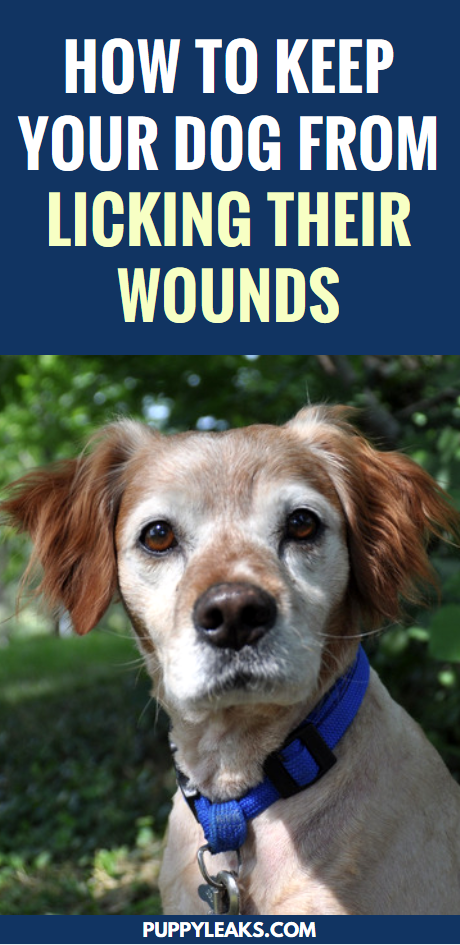
Please share with your friends



